Overview
Communicating with data is crucial for professionals, as it empowers informed decision-making and enhances operational efficiency by converting complex information into actionable insights. This article underscores the significance of tailored messaging, effective visualization, and ethical practices. Organizations that prioritize data communication can notably improve collaboration, minimize errors, and cultivate a data-driven culture. By focusing on these elements, professionals can foster a more effective work environment, ultimately leading to better outcomes.
Introduction
In an age where data reigns supreme, the ability to communicate insights clearly and effectively has become a vital skill for organizations striving to thrive in a competitive landscape. Effective data communication not only informs decision-making but also fosters collaboration, enhances operational efficiency, and drives strategic initiatives. With many businesses still grappling with communication challenges, the need for innovative strategies has never been more critical.
From leveraging advanced statistical tools to employing data storytelling techniques, organizations have a wealth of resources at their disposal to transform raw data into compelling narratives that resonate with diverse audiences. This article delves into the multifaceted world of data communication, exploring its importance, strategies for tailoring messages, and the ethical considerations that underpin successful practices.
Understanding the Importance of Data Communication
Communicating with data is essential in today’s information-driven environment, involving the clear and effective sharing of insights derived from analysis. This skill not only facilitates informed decision-making but also fosters collaboration among teams, ultimately driving strategic initiatives and enhancing operational efficiency. Organizations that prioritize communicating with data often experience significant advantages, such as reduced errors and increased productivity.
A striking statistic reveals that 45% of individuals reported no progress in their organizations’ interaction practices, underscoring the urgent need for improved strategies in this area.
Employing statistical tools like visualization, regression analysis, and hypothesis testing can significantly enhance the accuracy of predictions and the development of effective strategies. For instance, Power BI services improve reporting and provide actionable insights through features like the 3-Day Power BI Sprint, which allows for the rapid creation of professionally designed reports. Additionally, the General Management App offers comprehensive oversight and intelligent evaluations, vital for addressing information inconsistency and governance challenges in business reporting, ultimately leading to better decision-making.
Moreover, expert insights affirm that effective communicating with data is crucial for operational efficiency. A case study showcasing enhancements in operational efficiency through GUI automation in a mid-sized company exemplifies this point. By automating data entry and software testing, the company achieved a 70% reduction in input errors and an 80% increase in workflow efficiency.
When teams can easily comprehend and act on findings through effective data communication, they are better equipped to optimize processes and enhance overall performance. The impact of efficient information exchange extends beyond immediate operational benefits; it plays a critical role in shaping long-term strategic direction. By transforming raw data into actionable knowledge, organizations empower their teams to make decisions aligned with their objectives, ultimately promoting growth and innovation.
Furthermore, integrating Robotic Process Automation (RPA) can further boost productivity by automating repetitive tasks, enabling teams to concentrate on more strategic initiatives.
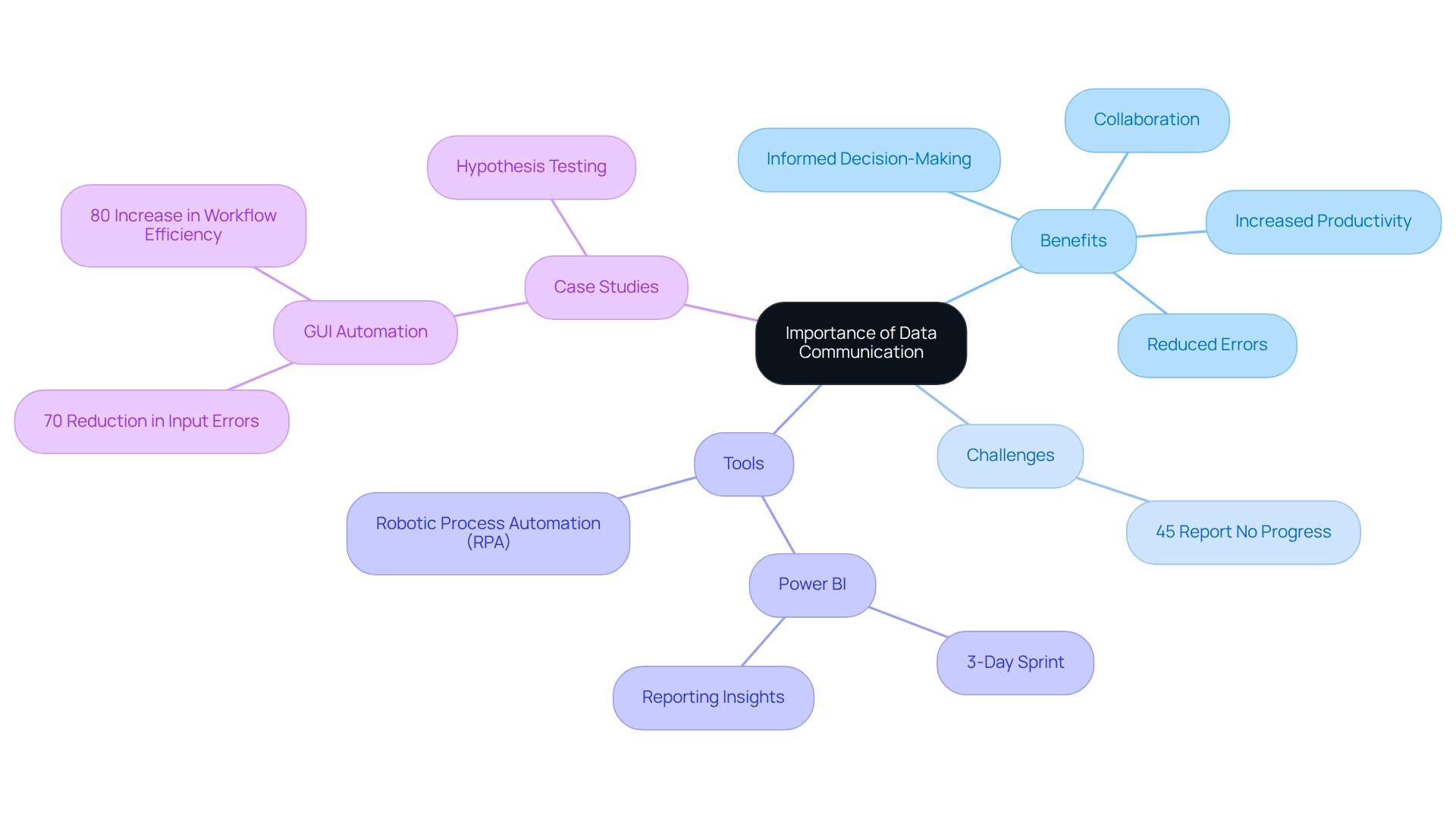
Identifying Your Audience: Tailoring Your Message
Effective communication with data begins with a thorough understanding of your listeners. Analyzing demographics, professional backgrounds, and familiarity with the subject matter is essential. This can be accomplished through surveys or interviews, offering valuable insights into viewer preferences and expectations.
Once you have a comprehensive profile of your listeners, you can tailor your message to resonate with them.
In the context of the rapidly evolving AI landscape, navigating the overwhelming options available is crucial. Tailored AI solutions from Creatum GmbH can help cut through the noise, providing targeted technologies that align with your specific business goals and challenges. For instance, when addressing technical experts, incorporating industry-specific terminology and detailed data analysis can enhance engagement.
In contrast, when engaging with a non-technical group, simplifying your language and emphasizing high-level insights is crucial. This customized approach not only enhances understanding but also fortifies the bond with your listeners, making your message more powerful.
The significance of audience evaluation is underscored by the reality that conducting such an assessment can require three to four weeks, depending on the accessibility of existing information and the necessity for further stakeholder feedback. As Geoff Ainscow, Leader of the Beyond War movement, observed, “He wanted to demonstrate that the U.S. and the USSR had weapons capable of obliterating the planet multiple times,” emphasizing the vital importance of clear expression in conveying intricate information.
Moreover, a significant shift towards a data-first culture has been observed, with over 80% of companies focusing on communicating with data through analytics across various departments. This trend highlights the importance of communicating with data to utilize Business Intelligence for converting raw information into actionable insights, facilitating informed decision-making that propels growth and innovation. By applying customized messaging approaches and utilizing BI, organizations can greatly improve engagement with their target group and promote more efficient information exchange.
Additionally, failing to utilize BI effectively can leave your business at a competitive disadvantage, making it imperative to adopt these strategies.
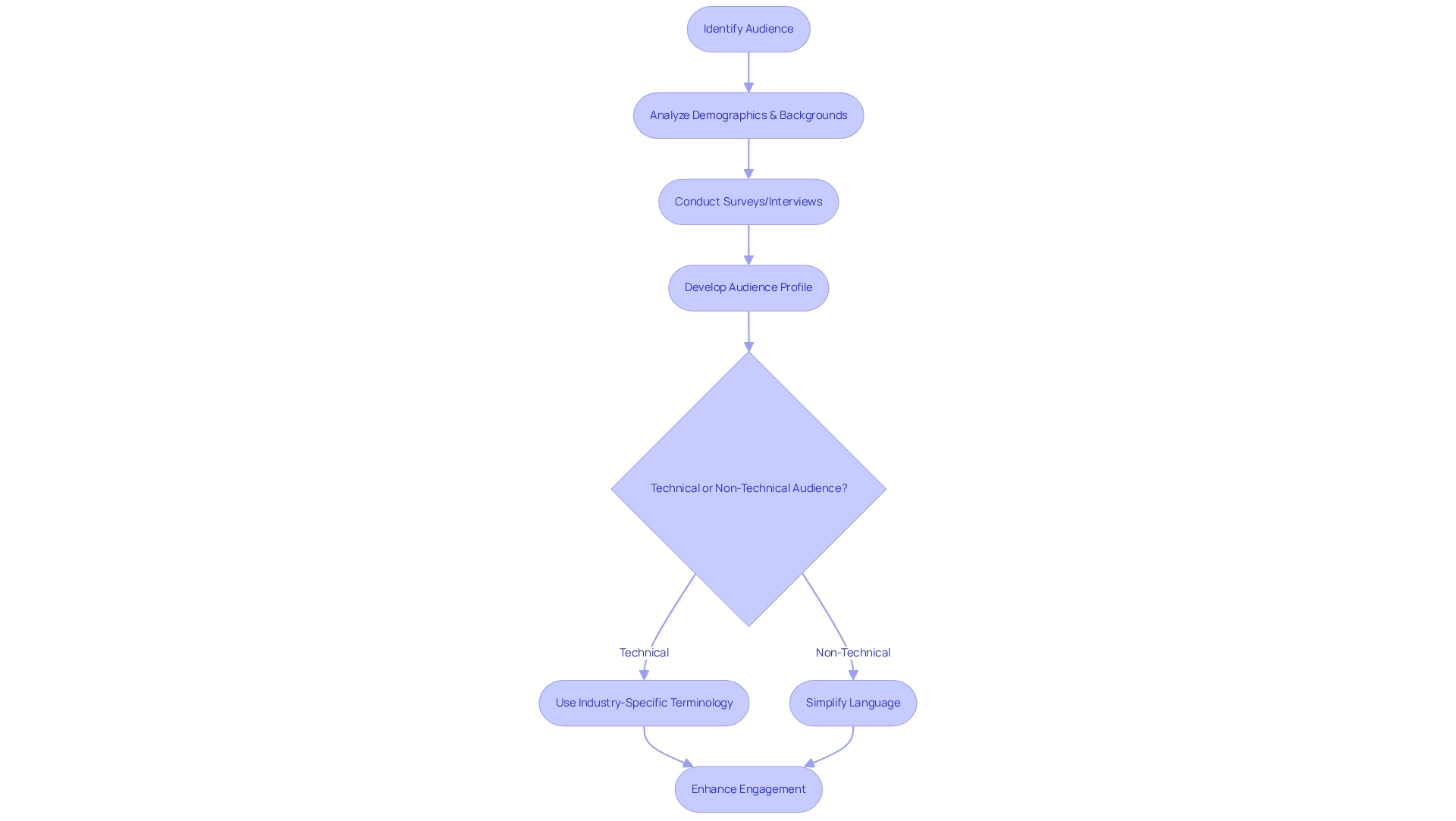
Simplifying Complex Data for Clarity
Complex information can often overwhelm audiences, leading to confusion and misinterpretation. To effectively simplify this complexity, begin by pinpointing the key messages you wish to convey. Utilize information aggregation methods for communicating with data to distill large datasets into actionable insights, making the information more digestible.
For instance, firms utilizing advanced analytics and AI are 2.5 times more likely to outshine their counterparts in innovation, highlighting the importance of clear information communication.
Visual aids, such as charts and graphs, play a crucial role in illustrating trends and patterns. Instead of presenting raw numbers, consider using a bar chart to depict sales growth over time, significantly enhancing comprehension. A case study from the healthcare sector demonstrates this approach: by merging patient records, laboratory results, and demographic data, healthcare providers achieved more accurate diagnoses and personalized treatment plans, ultimately improving patient outcomes and reducing treatment costs by approximately 15%.
Moreover, it is essential to avoid jargon and overly technical terms that may distance your viewers. By prioritizing clarity and simplicity, you can ensure that your audience grasps the essential insights without getting lost in the details. As Sarah Lee, a Market Research Enthusiast and Data Analytics Professional, states, “Embrace this revolution in market research, and let information aggregation be your guide in unlocking unprecedented potential in your organizational strategies!”
Additionally, using tools such as Power BI from Creatum GmbH can enhance your reporting capabilities by effectively communicating with data, ensuring efficient reporting and consistency. The 3-Day Power BI Sprint allows for the rapid creation of professionally designed reports, while the General Management App provides comprehensive management and smart reviews. Embracing these strategies not only facilitates better understanding but also empowers organizations to unlock unprecedented potential in their strategies.
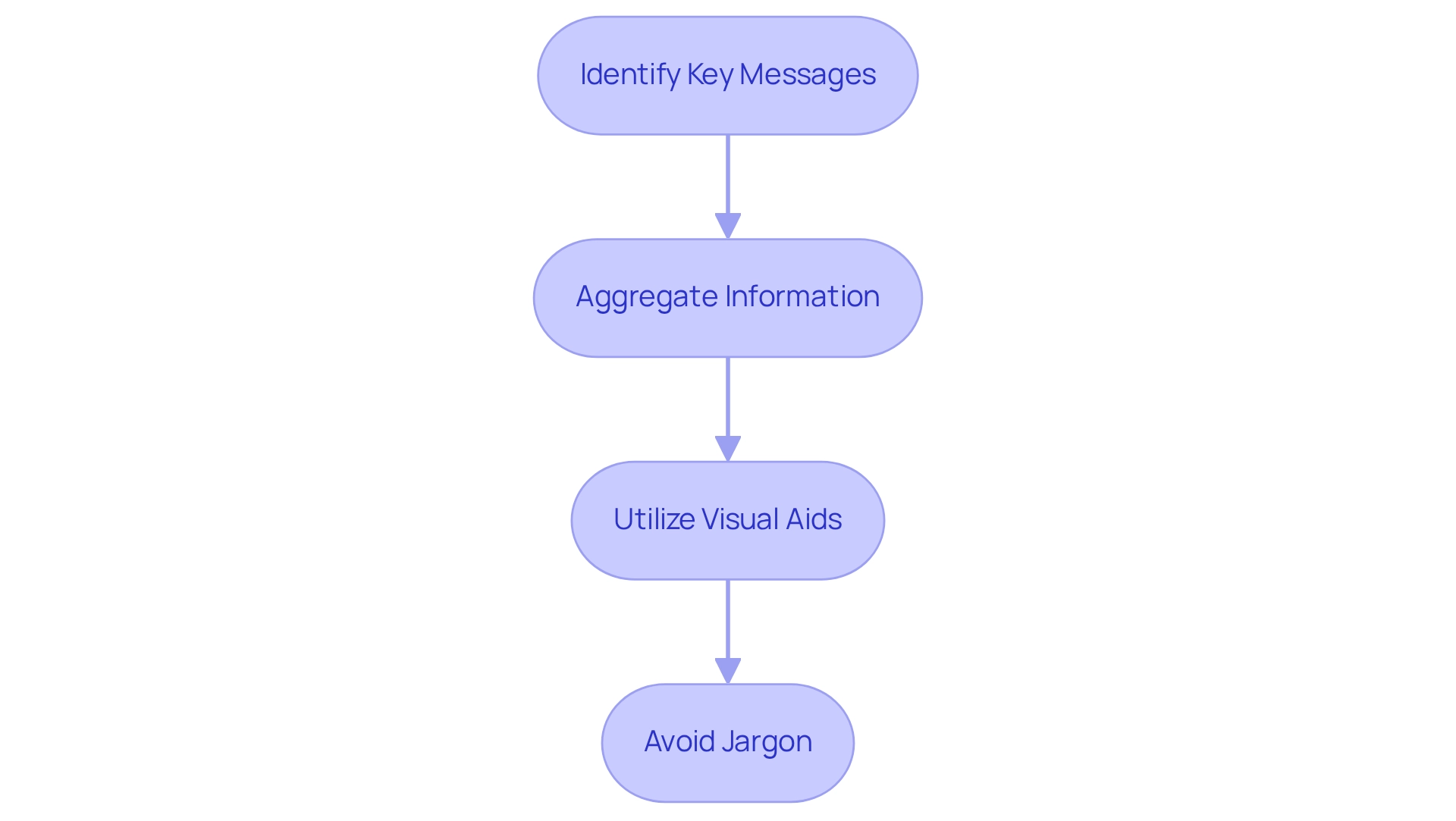
The Art of Data Storytelling: Engaging Your Audience
Information storytelling transforms unprocessed data into compelling narratives that resonate with audiences. To begin, identify the core message you wish to convey and the insights that underpin this message. Employ a narrative framework comprising a beginning (context), a middle (insights), and an end (conclusion or call to action). This structure not only organizes your presentation but also boosts audience engagement.
Incorporating anecdotes or real-life examples significantly enriches your narrative. For instance, when presenting sales information, consider sharing a success story that illustrates how a specific strategy led to increased revenue. This approach not only renders the data relatable but also fortifies the insights you communicate.
The impact of effective storytelling with information is underscored by statistics indicating that fundraising campaigns utilizing video garner 114% more funding than those that do not. This statistic emphasizes the power of visual and narrative elements in enhancing engagement. Furthermore, improving information literacy within your workforce is essential for overcoming challenges in adopting storytelling techniques, equipping team members with the skills necessary to analyze and convey information effectively.
A notable example of transformative information communication is PALFINGER Tail Lifts GMBH’s experience with Creatum GmbH’s Power BI Sprint service. They received not only a ready-to-use Power BI report and gateway setup but also witnessed a remarkable acceleration in their Power BI development. The results exceeded their expectations and provided a crucial enhancement to their analytical strategy, demonstrating the effectiveness of Creatum’s approach in elevating business intelligence.
Creatum GmbH is committed to developing solutions that foster behavioral transformation through collaboration, creativity, and a focus on excellence. By addressing inconsistencies and governance challenges, our services empower businesses to make informed decisions based on reliable information.
Additionally, a significant 75% of marketers prefer Microsoft Office for visualizations, underscoring the importance of familiar tools in enhancing information communication.
In conclusion, integrating a narrative into your presentations not only captures your audience’s attention but also amplifies the impact of the information shared. Successful examples of information storytelling, such as Arab News’s ‘Jews of Lebanon’ and ThoughtSpot’s ‘Are Hurricanes Getting Worse?’, illustrate how visual representations can effectively convey complex information, further emphasizing the importance of storytelling in delivering insights.
Discover how Creatum GmbH can assist you in transforming your storytelling and driving meaningful change within your organization.

Choosing the Right Format: Reports, Dashboards, and More
Choosing the suitable format for information presentation is crucial for effective data communication. Common formats include reports, dashboards, and presentations, each serving distinct purposes. Reports are ideal for thorough analysis, providing extensive information and insights that address detailed inquiries.
In contrast, dashboards offer a concise overview of key performance indicators (KPIs), making them ideal for swift decision-making and real-time monitoring.
When deciding on the appropriate format, it is essential to consider the viewers’ requirements and the context in which the information will be presented. For instance, when conveying complex data to individuals without technical expertise, a visually engaging dashboard that highlights key metrics can be significantly more effective than an extensive report filled with intricate details. This approach not only enhances comprehension but also fosters involvement, as viewers are more likely to connect with visual narratives.
As Ashish Arora aptly puts it, “Imagine standing before a group, waiting to deliver a presentation for which you have been working for months.” This underscores the importance of preparation and the right format in ensuring a successful presentation.
Recent trends emphasize the significance of narrative storytelling in presentations, which can greatly enhance audience engagement. By anticipating potential questions and preparing insightful answers, presenters can cultivate constructive dialogues that further clarify the implications of the information.
Statistics indicate a growing preference for mobile-first design in presentations, reflecting the increasing number of users accessing content via mobile devices. This shift necessitates that information presentations be adaptable and visually appealing across various platforms.
To address challenges in leveraging insights from Power BI dashboards, such as time-consuming report creation and inconsistencies, our Power BI services at Creatum GmbH provide enhanced reporting and actionable insights. Notably, the 3-Day Power BI Sprint facilitates the rapid creation of professionally designed reports, while the General Management App ensures comprehensive management and smart reviews. Additionally, our RPA solutions complement these services by automating repetitive tasks and improving operational efficiency.
This integration of effective tools highlights the importance of selecting the appropriate information presentation format, ultimately resulting in improved strategies for communicating with data and better decision-making outcomes.
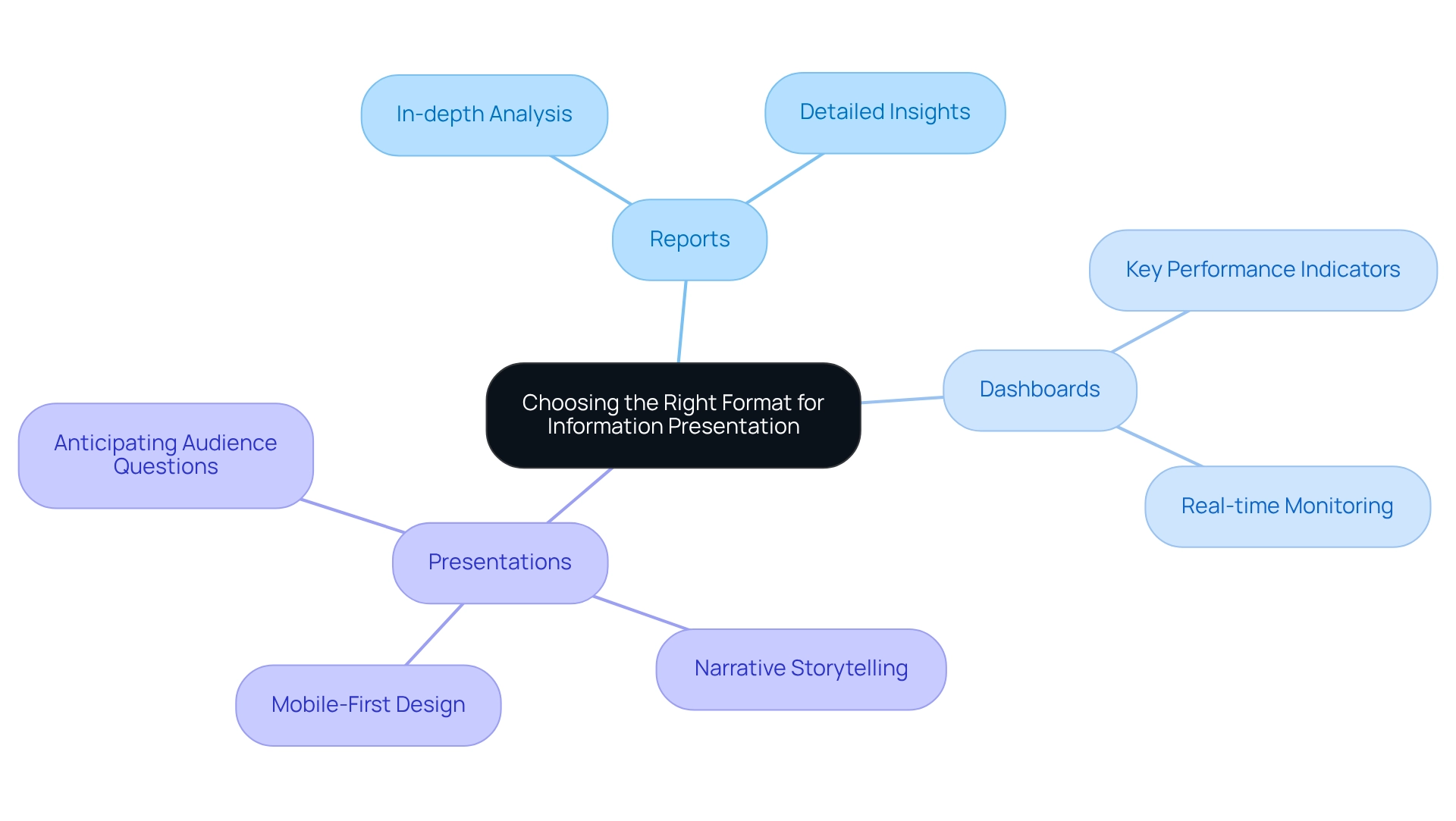
Visualizing Data: Enhancing Understanding Through Graphics
Data visualization is crucial for effective communication with data, significantly enhancing both comprehension and retention of information, especially in the context of the overwhelming AI landscape. By employing charts, graphs, and infographics, organizations can dramatically improve how information is presented. This is particularly true when customized solutions from Creatum GmbH are utilized to align with specific business objectives. Choosing the appropriate type of visual representation based on the characteristics of the information is essential.
For example:
- Line graphs excel at illustrating trends over time.
- Pie charts effectively convey proportions within a dataset.
To maximize clarity, visuals should be straightforward and uncluttered, using colors and labels strategically to direct the audience’s focus.
Moreover, incorporating interactive visualizations allows users to engage directly with the information, fostering a deeper understanding. This is increasingly important as companies seek to harness the power of Business Intelligence (BI) to transform raw data into actionable insights, facilitating informed decision-making that drives growth and innovation. Research indicates that effective information visualization can yield an impressive return on investment, with business intelligence tools showing an ROI of $13.01 for every dollar invested.
This underscores the importance of investing in quality visualization methods, particularly since effective communication with data can also enhance search engine rankings, as noted by content specialists such as Raja Antony Mandal.
Recent studies highlight the need for advancements in visual representation methods, particularly in developing guidelines for selecting appropriate visuals and improving the integration of various representations. The case study titled “Future Research Opportunities in Data Visualization” identifies several areas for future research that could lead to more effective practices in conveying complex information clearly and accurately. By adopting these effective information visualization techniques and prioritizing communication with data, professionals can transform complex content into accessible and engaging formats, ultimately driving better decision-making and operational efficiency.
Furthermore, addressing information inconsistency and governance challenges in business reporting is vital for improved decision-making, ensuring stakeholders receive clear, actionable guidance from their information. Engaging with impactful information-sharing methods early on is essential, as studies show that 80% of the brain’s ability to adapt occurs before the age of 5. This early engagement establishes a foundation for enhanced understanding and retention of information.
Additionally, Creatum GmbH’s Robotic Process Automation (RPA) solutions can significantly enhance operational efficiency by automating repetitive tasks. This approach tackles issues of information inconsistency and allows organizations to focus on strategic decision-making.
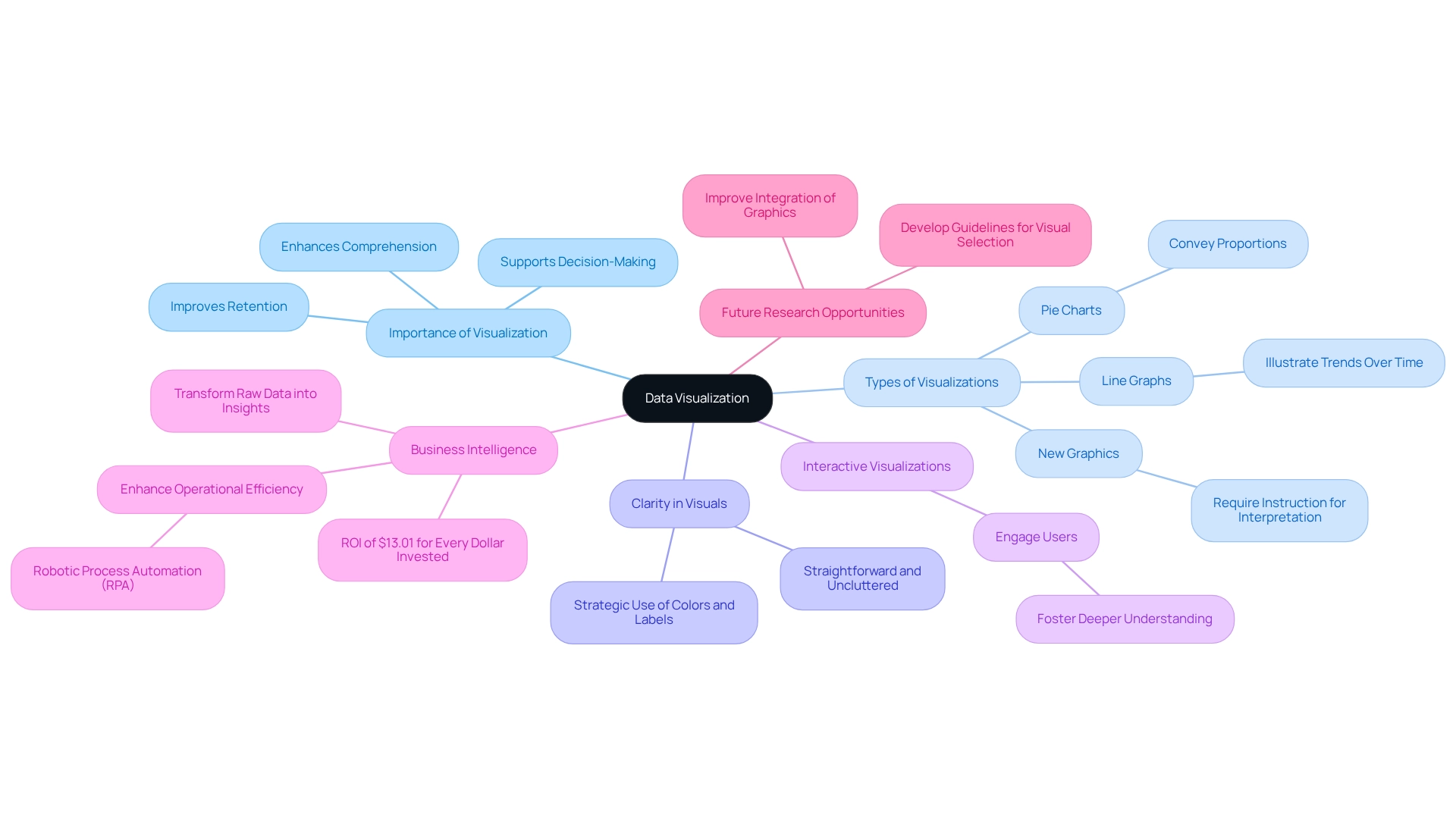
The Role of Feedback: Iterating for Better Communication
Feedback is crucial for enhancing the effectiveness of communicating with data, especially within Business Intelligence (BI) and Robotic Process Automation (RPA) solutions like EMMA RPA and Power Automate. After delivering a presentation, actively seek feedback from your audience to assess their understanding and pinpoint areas for improvement. Utilize various methods—surveys, informal discussions, or follow-up meetings—to gather valuable insights.
Analyzing this feedback can reveal common themes that inform adjustments to your messaging strategies. This is particularly relevant when using BI tools like Power BI, which can sometimes present challenges such as time-consuming report generation, inconsistencies in information, and issues stemming from insufficient master information quality.
As Gallup states, “In a development-focused work culture, feedback isn’t a one-way, top-down event.” This highlights the collaborative nature of feedback, essential for enhancing interaction. For instance, if audience members express confusion over specific data points, revising your presentation to clarify those aspects may be beneficial.
This iterative process not only sharpens your communication skills but also ensures your messages resonate clearly and effectively.
Statistics underscore the importance of feedback in fostering creativity and collaboration; studies indicate that 40% of employees believe consistent interaction enhances team creativity. This statistic supports the argument that feedback is vital for effective data communication. Furthermore, organizations utilizing internal messaging platforms like Slack or Microsoft Teams have reported significant improvements in employee interaction and collaboration.
These platforms facilitate instant messaging and real-time collaboration, streamlining workflows and enhancing interaction efficiency.
Incorporating feedback mechanisms into your data presentations is essential. Consider implementing digital signage to display real-time feedback, which can enhance internal interactions based on employee responses. This integration not only offers immediate insights but also cultivates a culture of continuous improvement.
By prioritizing feedback and leveraging BI and RPA solutions such as EMMA RPA and Power Automate, you can create a more dynamic and responsive strategy focused on data communication, improve information presentation, and boost overall organizational efficiency. Additionally, addressing barriers to AI adoption will further reinforce your approach to utilizing tailored AI solutions in your operations.
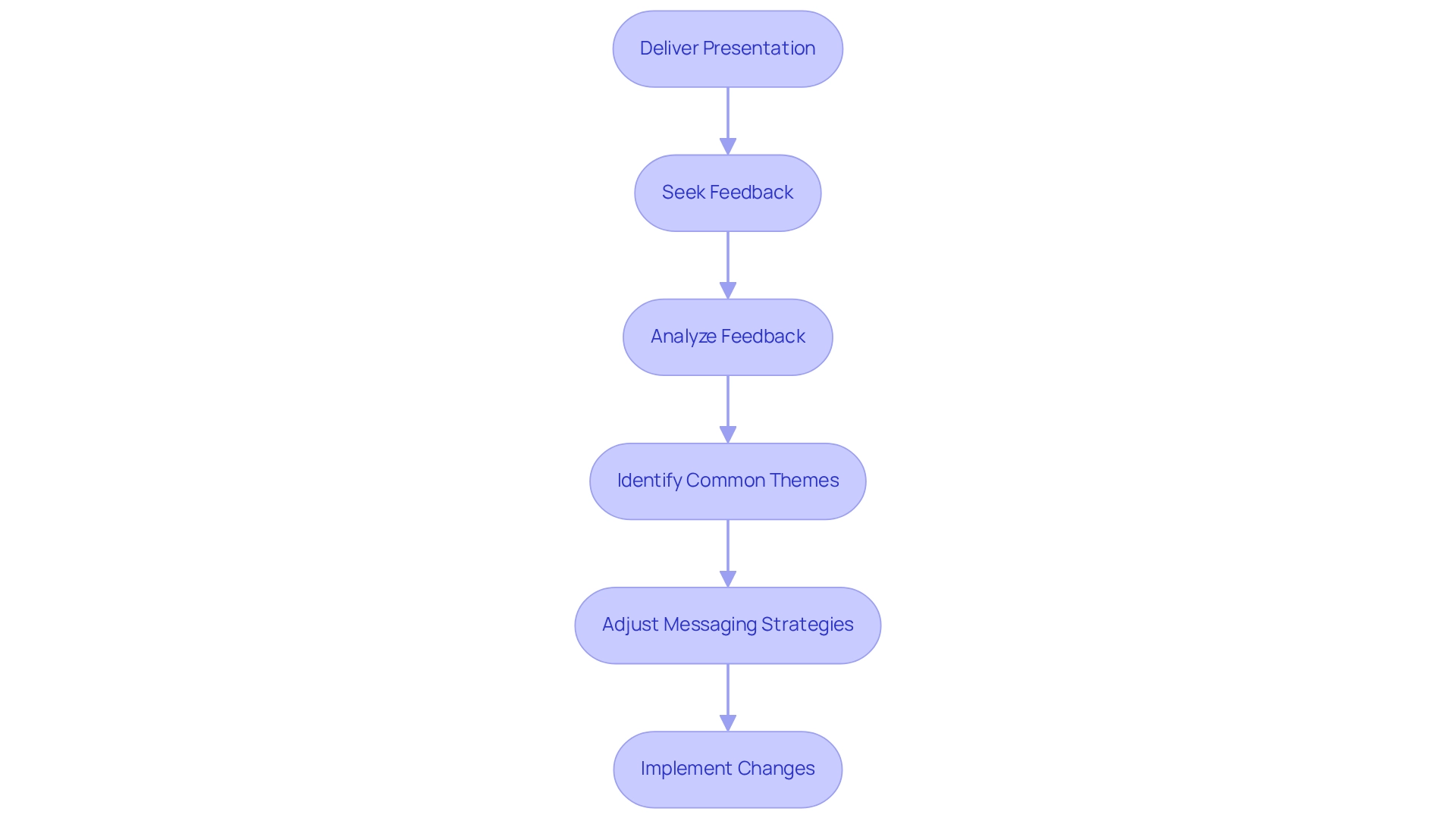
Ethical Considerations in Data Communication
Ethical considerations in communicating with data are essential for fostering trust and integrity within any organization. Openness regarding sources and methodologies is crucial, as it guarantees that stakeholders can evaluate the trustworthiness of the information provided. Manipulating information to mislead audiences undermines credibility and can lead to significant repercussions, as demonstrated in high-profile cases like the Facebook-Cambridge Analytica scandal, which highlighted the dangers of unethical information practices.
In contrast, organizations like Apple and IBM exemplify positive practices in information ethics, demonstrating how transparency enhances trust and accountability.
Organizations must remain vigilant about privacy concerns when sharing sensitive information. The 2016 Uber security incident, which revealed the personal information of 57 million users and drivers, serves as a stark reminder of the potential consequences of ignoring ethical standards. Uber’s choice to compensate hackers $100,000 to erase the information and maintain the breach’s secrecy illustrates the severe consequences of failing to prioritize ethical practices.
As Uber stated, “In 2016, we experienced a breach that exposed the personal information of 57 million users and drivers,” emphasizing the critical need for robust protection measures.
Furthermore, the impact of communicating with data extends beyond mere figures; it influences perceptions and choices among various stakeholders. When guests post remarks on a website, organizations such as Creatum GmbH gather information like the visitor’s IP address and browser user agent string to assist with spam detection. Anonymized strings created from email addresses may be shared with services like Gravatar, raising additional privacy considerations.
The Gravatar service privacy policy is available here: https://automattic.com/privacy/. Following the endorsement of remarks, profile images become accessible to the public, emphasizing the significance of handling user information responsibly. Privacy issues also emerge when images containing embedded location information (EXIF GPS) are uploaded, necessitating careful management of such information.
When presenting information related to employee performance, it is vital to ensure that it is conveyed fairly and without bias. This approach upholds ethical standards and cultivates a culture of accountability and trust within the organization.
Training programs centered on information ethics are crucial for integrating these principles into the organizational culture. Such initiatives enable employees to comprehend and apply ethical practices regarding information, ensuring that ethical considerations are prioritized in all aspects of information management. The case study on ‘Training and Awareness in Ethical Practices’ emphasizes the necessity for formal training programs to guarantee that all employees understand and can apply ethical practices regarding information.
Moreover, statistical practitioners must manage participant data carefully to ensure confidentiality, reinforcing the overall theme of ethical data exchange. By committing to transparency and ethical communication, organizations can enhance their reputation and foster stronger relationships with their stakeholders through effective communication with data.
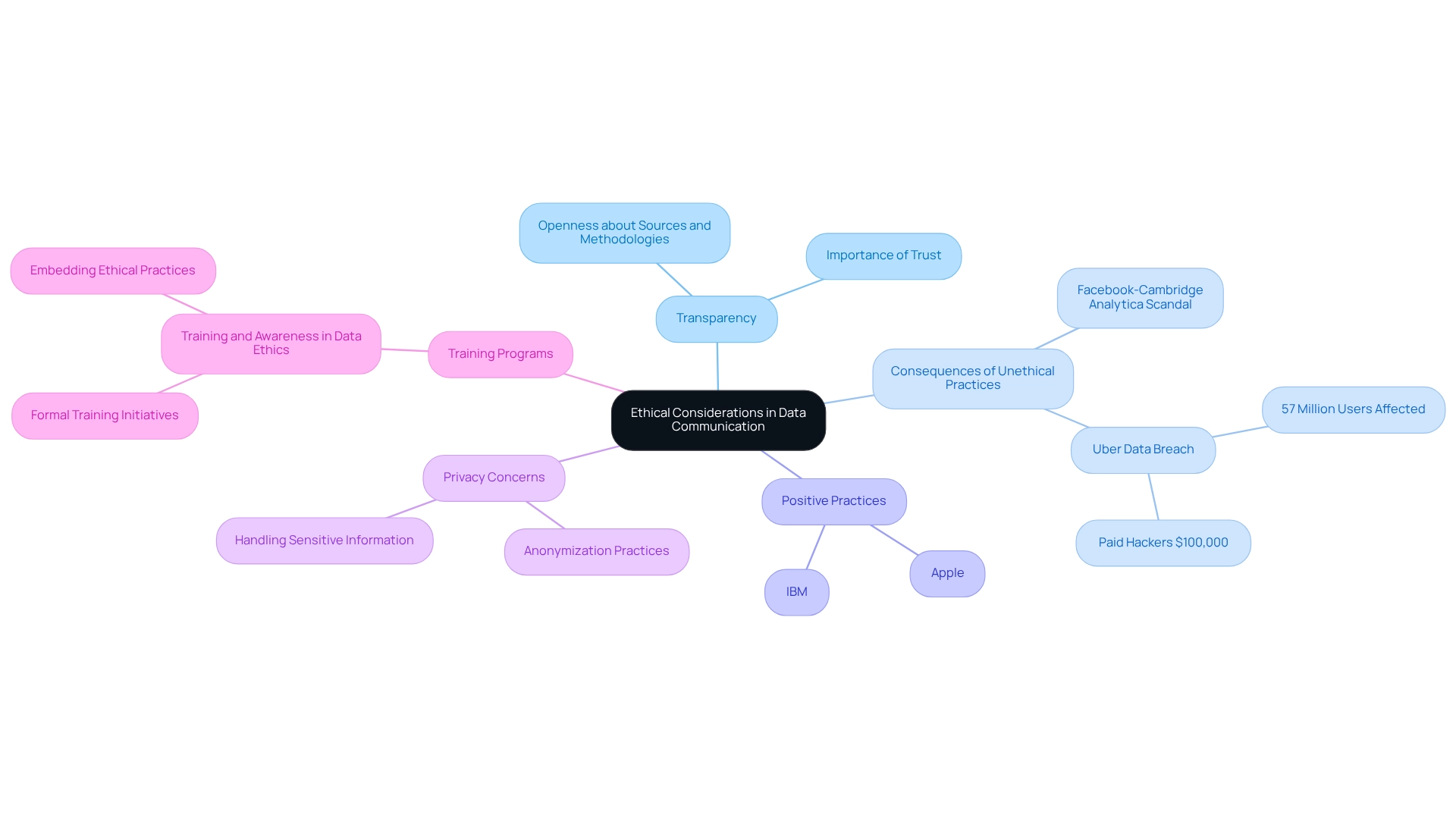
Conclusion
Effective data communication is paramount in today’s rapidly evolving landscape. The ability to convey insights clearly can significantly impact organizational success. This article highlights several key aspects of this discipline: from understanding the importance of data communication to the ethical considerations that must be upheld. Organizations that prioritize effective communication can enhance decision-making, foster collaboration, and drive strategic initiatives, ultimately leading to improved operational efficiency.
Tailoring messages to the audience is crucial. This approach ensures that insights resonate and are easily understood. By employing techniques such as data storytelling and visualization, complex information can be transformed into compelling narratives that engage and inform. The choice of format—whether reports, dashboards, or presentations—also plays a significant role in how effectively data is communicated.
Moreover, the importance of feedback in refining communication strategies cannot be overstated. Actively seeking audience input can lead to iterative improvements that enhance clarity and engagement. Ethical considerations in data communication are critical; transparency and integrity are essential for building trust and credibility with stakeholders.
In conclusion, mastering the art of data communication equips organizations with the tools to convey information effectively and cultivate a culture of informed decision-making. By embracing innovative strategies and ethical practices, organizations can unlock the full potential of their data, driving growth and fostering a competitive edge in an increasingly data-driven world.
Frequently Asked Questions
Why is communicating with data important in today’s environment?
Communicating with data is essential as it facilitates informed decision-making, fosters collaboration among teams, drives strategic initiatives, and enhances operational efficiency.
What advantages do organizations gain by prioritizing data communication?
Organizations that prioritize communicating with data often experience reduced errors and increased productivity.
What percentage of individuals reported no progress in their organizations’ interaction practices?
A striking 45% of individuals reported no progress in their organizations’ interaction practices, highlighting the need for improved strategies.
What statistical tools can enhance data communication and analysis?
Statistical tools such as visualization, regression analysis, and hypothesis testing can significantly enhance the accuracy of predictions and the development of effective strategies.
How does Power BI contribute to data communication?
Power BI services improve reporting and provide actionable insights through features like the 3-Day Power BI Sprint, which allows for the rapid creation of professionally designed reports.
What role does the General Management App play in data communication?
The General Management App offers comprehensive oversight and intelligent evaluations, addressing information inconsistency and governance challenges in business reporting, ultimately leading to better decision-making.
Can you provide an example of improved operational efficiency through data communication?
A case study showed that a mid-sized company achieved a 70% reduction in input errors and an 80% increase in workflow efficiency by automating data entry and software testing.
How does effective data communication impact team performance?
When teams can easily comprehend and act on findings, they are better equipped to optimize processes and enhance overall performance, which also influences long-term strategic direction.
What is the benefit of integrating Robotic Process Automation (RPA) in data communication?
Integrating RPA can boost productivity by automating repetitive tasks, allowing teams to focus on more strategic initiatives.
What is the first step in effective communication with data?
The first step is to thoroughly understand your listeners by analyzing their demographics, professional backgrounds, and familiarity with the subject matter.
How can audience evaluation improve data communication?
Tailoring messages based on audience evaluation enhances understanding and engagement, making the communication more powerful.
What trend has been observed regarding the use of data in organizations?
Over 80% of companies are focusing on communicating with data through analytics across various departments, indicating a significant shift towards a data-first culture.
What can happen if a business fails to utilize Business Intelligence (BI) effectively?
Failing to utilize BI effectively can leave a business at a competitive disadvantage, making it imperative to adopt data communication strategies.

